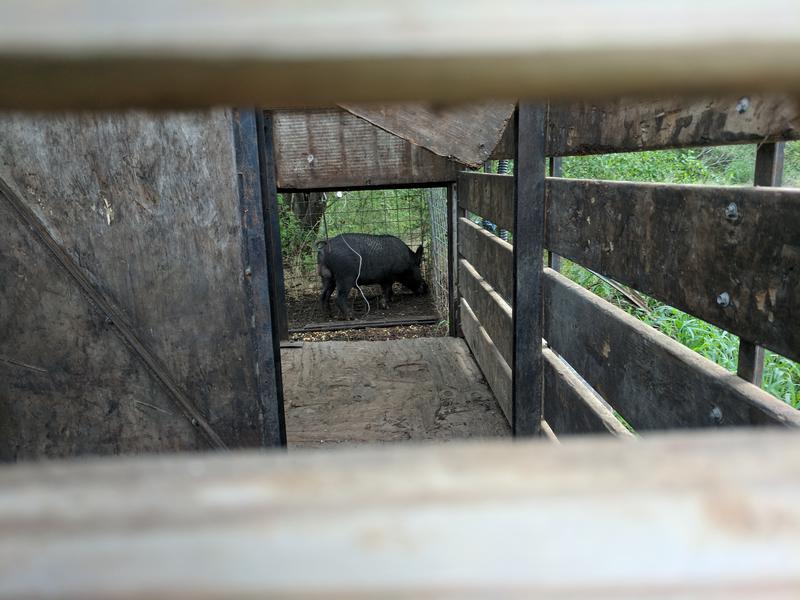From Texas Public Radio:
At 2.6 million, there are more feral pigs in Texas than any other state. They do an estimated $52 million worth of damage to the state’s agriculture.
Hovering a few hundred feet above a cotton field outside College Station, Chase Roberts is pointing out just some of that damage.
“This is all pig damage. This is what pig damage looks like,” he says over the radio of his Robinson R44 helicopter. We’re looking down over dozens of big, muddy holes that have been rooted and wallowed in.
Four days a week, Roberts pilots hunters over the more than 300,000 acres they have permission to as part of his business, HeliBacon. Flying out before dawn, he and at least two hunters fly out, often with semi-automatic AR-15s, to reduce Texas’ pig population.
Born of a love of helicopters and guns, the helicopter hunting group is one of 143 businesses licensed for aerial wildlife management according to state records. In 2016, 34,000 pigs were killed in helicopter hunts.
“There’s three along that fenceline,” says HeliBacon co-owner Chris Britt over the radio. He’s riding in the back seat of the helicopter pointing to three pigs shot in that mornings hunt. The pigs are big. One looks like it is over 300 pounds.
“You can already see the rib cage on that one. They killed that just a few hours ago,” says Britt.
In contrast to other experiential hunting trips, like night vision hunting, helicopter hunts often leave the pigs behind which can be seen as wasteful.
Britt says that this isn’t sport hunting. This is aerial pest-control. Britt says for farmers they are big mice, and “no one ever says when you catch a mouse with a mouse trap and throw it away you are wasting the meat.”
Besides, any remains from the pig will be devoured by buzzards, and other animals in the next 36 hours, says Roberts.
According to Britt, 500 people have used HeliBacon this year, pretty evenly split between businesses bringing their employees, and individuals. Very few come from within the state, and it isn’t uncommon for international visitors. Two hours runs more than $3500, and while it is a service for farmers it is entertainment for his clients.
“It’s an intense two hours, a very memorable two hours,” says one client from Chicago named Tim. Tim represents a typical Helibacon client. He has hunted but isn’t an avid hunter. He is from out of state and heard about it over the Internet.
“It’s just something you can experience here in Texas,” explains Tim.
Tim asked that his last name not be published because of concerns over backlash.
It isn’t uncommon for operators to get threats over social media. Britt confirms they get a lot of negative feedback from the Internet, but business is booming.
Right now Helibacon is considering upgrading to a seven-seat helicopter, and Britt wants to mount a gatling gun on it.
Unlike Helibacon, which sees those pigs as a never-ending source of moving targets, Bubba Ortiz sees them as a never-ending source of protein.
Ortiz runs Ortiz Game Management. He is baiting one of his traps on marshy land on the southeast outskirts of San Antonio.
By contracting with property owners like this one, he has made this his full-time job, and he is one of only a few in the county that have been able to do that.
“I have friends of mine who’re like, ‘Yeah, but you get paid to go hunting.’ I’m like, it’s not like that dude. It’s hot. It’s dirty. Bugs, spiders, snakes.” he says swiping away fire ants on his legs.
Another reason it isn’t like that, is because in order for him to collect additional money from a processing plant, any pig he catches has to be alive when he delivers it.
We come upon one of his traps with an adult male pig in it. It’s probably 150 pounds. It is thrashing against the metal sides and has managed to bend the front gate out so that it isn’t closed properly.
“You hear that chomping?” asks Ortiz.
The pig is making loud chomping noises as it stares at us before ramming his head against the pen again. The pigs nose is bleeding.
“That’s him giving you a warning.”
According to Texas A&M Agrilife Extension, Ortiz should get between $.10 and $.20 per pound, but he says the rates are very fluid.
Ortiz believes these pigs should be part of the U.S. diet, but most people think of the meat as gamy or dirtier than domestic pigs. He says that is wrong.
“This is good meat,” Ortiz says. “It’s free range, self-sustaining food source, and it’s a problem. We got a million hungry Texans. Why aren’t the two connecting?” he asks.
















